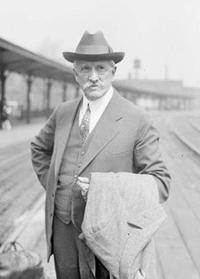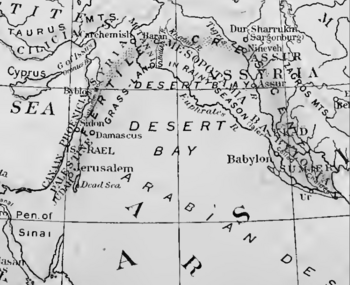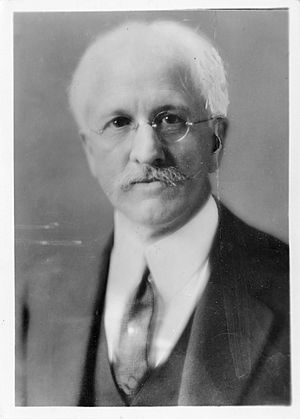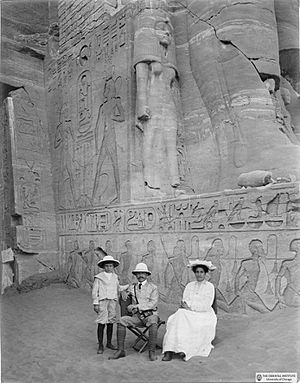James Henry Breasted facts for kids
Quick facts for kids
James Henry Breasted
|
|
|---|---|

James Breasted in Chicago, 1928.
|
|
| Born | August 27, 1865 |
| Died | December 2, 1935 (aged 70) |
| Nationality | American |
| Alma mater |
|
| Known for | Popularizing the term "Fertile Crescent" Founder of the Oriental Institute |
| Scientific career | |
| Fields | |
| Institutions | University of Chicago |
| Thesis | De hymnis in Solem sub rege Amenophide IV conceptis (1894) |
| Doctoral advisor | Adolf Erman |
| Doctoral students | Robert John Braidwood |
James Henry Breasted (born August 27, 1865 – died December 2, 1935) was an American archaeologist, Egyptologist, and historian. He was a very important person in studying ancient civilizations, especially those in Egypt.
After finishing his PhD in Berlin in 1894, he joined the University of Chicago. In 1901, he became the director of the Haskell Oriental Museum there. He focused a lot on ancient Egypt. By 1905, Breasted became a full professor. He held the first special teaching position in the United States for Egyptology and Oriental History.
In 1919, he started the Oriental Institute at the University of Chicago. This institute was a place to study ancient civilizations from different angles. Breasted loved doing research in the field. He was very interested in writing down and understanding old writings. He especially wanted to save information from sources and buildings that he feared might be lost forever.
Contents
Early Life and Education
James Henry Breasted was born on August 27, 1865. His family lived in Rockford, Illinois. His father owned a small hardware store. James went to local public schools. Then he attended North Central College, which was called North-Western College back then.
He graduated in 1888. After that, he went to Chicago Theological Seminary. But he soon moved to Yale University to study Hebrew. There, he learned from William Rainey Harper, who greatly influenced how the language was taught. James earned his master's degree from Yale in 1891.
His mentor, Harper, became president of the University of Chicago. Harper told Breasted to study for his doctorate at the University of Berlin. He also encouraged Breasted to join him in Chicago later. Breasted studied the Egyptian language with Adolf Erman. Erman had just started a new way of studying Egyptology. This new way focused on grammar and how words were used.
Breasted earned his doctorate in 1894. His main project was editing the sun hymns from the El 'Amǎrneh period. He was the first American to get a PhD in Egyptology.
Marriage and Family
In 1894, James Breasted married Frances Hart. Frances and her sisters were in Germany at the same time as Breasted. They were learning the German language and studying music. The couple went to Egypt for their honeymoon. It was also a working trip for Breasted. He was asked to gather a collection of ancient Egyptian items for the University of Chicago.
Frances Hart Breasted passed away in 1919. They had been married for 25 years. After his wife's death, Breasted married one of her sisters.
His Work as an Archaeologist

Breasted made the term "Fertile Crescent" famous. This term describes an important area for archaeology. It includes parts of modern-day Iraq, Syria, Turkey, Lebanon, Jordan, Palestine, and Israel.
Breasted became a teacher at the University of Chicago in 1894. This was soon after he earned his doctorate. Five years later, the university let him accept an invitation. The Prussian Academy of Sciences wanted him to work on their Egyptian dictionary project. From 1899 to 1908, he worked in Egypt. This work helped him become well-known.
He started to publish many articles and books. One of his important books was History of Egypt from the Earliest Times Down to the Persian Conquest in 1905. At that time, he became a Professor of Egyptology and Oriental History at Chicago. This was the first such teaching position in the United States.
Founding the Oriental Institute
In 1901, Breasted became the director of the Haskell Oriental Museum. This museum opened at the University of Chicago in 1896. It was the start of the Oriental Institute. The museum had art from both the Near East and the Far East. But Breasted was most interested in Egypt.
He began to collect all the existing hieroglyphic writings. This collection was published in 1906 as Ancient Records of Egypt. It is still an important collection of translated texts today. Peter A. Piccione wrote in 2001 that it "still contains certain texts and inscriptions that have not been retranslated since that time."
As Breasted built up the museum's collection, he dreamed of starting a research institute. He wanted it to be "a laboratory for the study of the rise and development of civilization." This institute would trace Western civilization back to its beginnings in the ancient Middle East. After World War I, he saw a chance to make this happen.
He wrote to John D. Rockefeller Jr., whose family gave a lot of money to the university. Breasted suggested starting what would become the Oriental Institute. He planned a research trip through the Middle East. He believed the area was ready for scholars to visit. Rockefeller promised $50,000 over five years for the Oriental Institute. He also promised another $50,000 to the University of Chicago. The university added more support. In May 1919, the Oriental Institute was officially started.
Breasted had two main goals for his field trip. First, he wanted to buy ancient items for the Oriental Institute. Second, he wanted to choose places for future excavations. His research group included Breasted and four of his students.
Expedition Travels
The expedition traveled a lot:
- August 1919: From Chicago to England, sailing through New York and France.
- September 1919: In England.
- October 1919: From England to Cairo, going through Paris, Venice, and Alexandria.
- November 1919: In Egypt.
- December 1919: In Egypt.
- January 1920: In Egypt.
- February 1920: From Egypt to Bombay.
- March 1920: From Bombay to Basra, Mesopotamia (now Iraq).
- April 1920: In Mesopotamia.
- May 1920: From Mesopotamia to Arab State (today Syria) and Beirut.
- June 1920: From Damascus to Jerusalem, Haifa, Cairo, and London.
- July 1920: Back to Chicago.
As Breasted looked for future archaeological sites and visited dealers, he met many British leaders and scholars in Egypt. These included Gertrude Bell, Howard Carter, and Lord Allenby. He also met the Arab leader Faisal, who would become king of Iraq. Because Breasted traveled so much and knew about the Middle East's politics, Lord Allenby asked him for help. Allenby was the High Commissioner for Egypt. He asked Breasted to tell the British Prime Minister about the local people's dislike of the British forces.
Breasted's purchases were very important for the Oriental Institute's collections. One of his most famous purchases was the mummy of Meresamun. She was a singer in the Temple of Amun at Karnak.
Important Discoveries and Projects
The first excavation by the Oriental Institute was in Egypt at Medinet Habu. This was one of the places Breasted had suggested. Breasted often returned to Egypt. Between 1922 and 1927, he helped Howard Carter with his excavation of Tutankhamun's tomb. Breasted used his skills to read ancient seals. He was there when they took apart the shrine that held the King's sarcophagus.
He also helped solve problems between Carter and the Egyptian authorities. These problems stopped the excavation for a while in 1924–25. Breasted was often joined in Egypt by his son Charles. Charles wrote reports about the Tutankhamun excavation for newspapers, using a different name.
Breasted also worked with his University of Chicago colleague Carl F. Huth, Jr.. They created a very popular series of historical maps. These maps were published in 1916 and sold separately. Later, they were made into a series of atlases. One of these was the European History Atlas, which was updated many times.
On April 25, 1923, Breasted became the first archaeologist to be chosen for the National Academy of Sciences. This honor helped make archaeology a respected field in American universities. He was also the president of the History of Science Society in 1926.
James Henry Breasted died in New York City on December 2, 1935. He got a serious infection after coming back from his last trip.
While in Chicago, Breasted had a house built near the university. Its carriage house was made to look like an ancient Egyptian mastaba (a type of tomb). The house is now used by a student group.
Breasted is buried in Greenwood Cemetery in Rockford, Illinois. His grave has a large stone cube from Aswan. It simply has his name and "historian and archaeologist" written on it.
The James Henry Breasted Prize was created in 1985 to honor him. The American Historical Association gives this award every year. It is given to a book in English that covers any history before the year 1000 AD.
Dawn of Conscience
Breasted's book Dawn of Conscience (1933) was very important to Sigmund Freud. Freud finished his book Moses and Monotheism in 1938, and Breasted's ideas influenced him.
It has now become a sinister commonplace in the life of the post-war generation that man has never had any hesitation in applying his increasing mechanical power to the destruction of his own kind. The World War has now demonstrated the appalling possibilities of man's mechanical power of destruction. The only force that can successfully oppose it is the human conscience – something which the younger generation is accustomed to regard as a fixed group of outworn scruples. Everyone knows that man's amazing mechanical power is the product of a long evolution, but it is not commonly realized that this is also true of the social force which we call conscience – although with this important difference: as the oldest known implement-making creature man has been fashioning destructive weapons for possibly a million years, whereas conscience emerged as a social force less than five thousand years ago. One development has far outrun the other; because one is old, while the other has hardly begun and still has infinite possibilities before it. May we not consciously set our hands to the task of further developing this new-born conscience until it becomes a manifestation of good will, strong enough to throttle the surviving savage in us? That task should surely be far less difficult than the one our savage ancestors actually achieved: the creation of a conscience in a world where, in the beginning, none existed.
—James Henry Breasted, The Dawn of Conscience, (1933) Prologue
Works
- A History of the Ancient Egyptians, James Breasted, New York Charles Scribner's Sons, 1908
See also
 In Spanish: James Henry Breasted para niños
In Spanish: James Henry Breasted para niños



